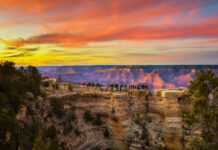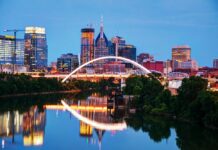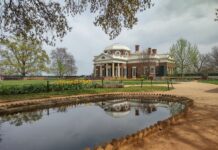 Before movies and TV became the launchpads for superstardom, explorers were the celebrities of the 19th and early 20th centuries. Along with adventurers such as Robert Peary (first at the North Pole) and Roald Amundsen (first at the South Pole), my great-grandfather, Hiram Bingham III, was one of the biggest.
Before movies and TV became the launchpads for superstardom, explorers were the celebrities of the 19th and early 20th centuries. Along with adventurers such as Robert Peary (first at the North Pole) and Roald Amundsen (first at the South Pole), my great-grandfather, Hiram Bingham III, was one of the biggest.
In 1911, he discovered in the mountains of Peru the ruins of “the lost city of the Incas,” otherwise known as Machu Picchu. Less than two years later, National Geographic devoted an entire issue to his discovery and its 1912 excavation, which had been funded by the National Geographic Society and Yale University, where he was on the faculty. His time in the spotlight didn’t end there. Great- Granddad went on to become lieutenant governor of Connecticut, a U.S. senator and good friend of President Calvin Coolidge.
These days, his celebrity status is still alive and well. Even if you’ve never heard of Hiram Bingham, you’ve undoubtedly heard of Indiana Jones, a character allegedly based on my great-granddad, right down to that famous fedora. (Interestingly, his grandfather, Hiram Bingham I, 1789-1869, the leader of the first Christian missionaries in Hawaii, was supposedly the basis for James Michener’s Abner Hale character in “Hawaii.” And family lore has it that his wife, Sybil, my great-great-great-grandmother, invented the muumuu to cover up native Hawaiians.)
I am Hiram Bingham’s oldest great-grandchild, and the only one to actually meet him, not that I remember. My mother, Clare Bingham Cochran, says he dandled me on his knee when she took me to visit him in Washington. He died when I was 2.
I do know that he was handsome and charming and that he wooed and wedded the granddaughter of Charles Tiffany, the founder of Tiffany & Co. The Tiffany family money bankrolled HB’s first expeditions, at least until his father-in-law had enough of his long absences from his wife and closed the checkbook for a time. Those absences grew longer when HB became a senator (and began a long affair with a congressman’s wife). That eventually led my great-grandmother to divorce him. (He later married the “other woman.”)
He was also a strict taskmaster with a classic Puritan streak. In a biography of his father, “Hiram Bingham: A Personal History,” my grandfather writes that his father didn’t allow any of his seven sons to read newspaper comics or novels of the day. Instead, he required them to read English classics. He introduced his sons to business by buying some chickens, forming a fictitious chicken company and selling his sons shares.
And despite the fact that HB died when I was a toddler, he remained a large presence in my life growing up. There was the summer home he and my great-grandmother built in Salem, Conn., where I spent my childhood summer vacations, its walls covered with the photos he took on his Machu Picchu expeditions.
 IIndeed I grew up— as all my siblings and many relatives did— believing that being a descendant of Hiram Bingham III made me special. In school, he was my claim to fame. At a high school reunion a few years back, one classmate divulged that the thing she remembers most about me was that day each year in Spanish class when we’d get to the page in the textbook that featured a photo of Machu Picchu. She could always count on me loudly (and annoyingly) proclaiming, “My great-grandfather discovered that!”
IIndeed I grew up— as all my siblings and many relatives did— believing that being a descendant of Hiram Bingham III made me special. In school, he was my claim to fame. At a high school reunion a few years back, one classmate divulged that the thing she remembers most about me was that day each year in Spanish class when we’d get to the page in the textbook that featured a photo of Machu Picchu. She could always count on me loudly (and annoyingly) proclaiming, “My great-grandfather discovered that!”
But in all the years since— filled with more than a few “my great-grandfather” boasts— I had never visited the place that made HB famous, and neither had my mother. That is, until last spring, when my friend Frances Reaves, who had spent some of her teenage years in Peru, took it upon herself to organize a girls-only trip for six of us through the luxury travel company Abercrombie & Kent.
It turned out to be a great blend of adventuresome personalities: Frances, a business incentive and development consultant; SunTrust Bank vice president Suzan Garabedian; architect Becky Swanston; former attorney Rose Carpenter; my mom, a painter and former interior designer now living in Connecticut; and me.
And it was an absolutely incredible trip: top-notch hotels, the best guide in the world, delicious food and enough pisco sours (the national drink made with a Peruvian grape-based brandy) to liven up more than one night on the road. The trip was memorable in itself, as anyone who has ever been to Machu Picchu (as well as Lima, Cuzco and Peru’s Urubamba Valley) will tell you. But what made this our trip of a lifetime was, of course, my connection to Hiram Bingham.
From the moment we touched down in Lima, we learned that Bingham’s rock star status continues to live on. When Peruvians discovered who we were related to, they acted like they had just met celebrities. And that was particularly true for my mother. People wanted their pictures taken with her. They wanted her business card— in fact, she ran out of them the first day we were there. The concierge at the Miraflores Park Hotel tracked down a printer who could print another 100 (at 9 at night!) so she’d have enough for the rest of our weeklong trip.
After a flight to Cuzco from Lima and a night’s stay in the Urubamba Valley, the six of us and our guide, Juan De Dios Castillo, took a train and then a bus to Machu Picchu. The last leg involved zig-zagging up the mountain via the Hiram Bingham Highway.
If you’ve ever heard anyone’s story about their visit to this spectacular site, you’ve heard words like “magical,” and “spiritual.” I don’t know what Mom was expecting. But, given our history, I was expecting my own personal thunderbolt when we walked through the entrance gates.
As we passed through a stone doorway, Machu Picchu opened up before us. It was mid-March, the end of the Amazonian rainy season, and everything was damp and misty and a vivid green. The lost city itself— miles of gray stone walls and terraces— was huge, so much bigger than any photograph could relate. But there was no personal thunderbolt. No metaphysical connection with my great-grandfather. Just awe.
I looked at Mom. Had a Hiram Bingham moment hit her? Nope. What struck her was how steep the place was. Photos — including those taken by HB himself— have a tendency to flatten out the scene. Yet, everything is literally built on the sides of the mountain.
 About 8,000 feet above sea level, Machu Picchu was constructed around 1450 by the Incas and abandoned approximately 100 years later when its builders were conquered by the Spanish. No one knows exactly what its purpose was. Initially, it was thought to be a religious or a defensive retreat. But the theory now is that Machu Picchu was a royal estate, the Inca ruler’s Versailles, if you will. It was never found by the Spanish and the Incas never had a written language, so its whereabouts were forgotten except by a few nearby Peruvians, who eventually led HB to the site. (That’s why Peruvians refer to his accomplishment as a “rediscovery.”)
About 8,000 feet above sea level, Machu Picchu was constructed around 1450 by the Incas and abandoned approximately 100 years later when its builders were conquered by the Spanish. No one knows exactly what its purpose was. Initially, it was thought to be a religious or a defensive retreat. But the theory now is that Machu Picchu was a royal estate, the Inca ruler’s Versailles, if you will. It was never found by the Spanish and the Incas never had a written language, so its whereabouts were forgotten except by a few nearby Peruvians, who eventually led HB to the site. (That’s why Peruvians refer to his accomplishment as a “rediscovery.”)
When I was young, I remember hearing the story about the “flash of stone” HB saw beneath tangled vines, which led him to a doorway into this “hidden kingdom.” That’s not the way it happened, but I wonder if that little fairy tale didn’t also make its way into the first Indiana Jones movie.
It took Great-Granddad a while to realize what he had come across. He had been looking for Vilcabamba, the lost capital city of the Inca empire, so he wasn’t really concentrating on Machu Picchu when the Peruvian villagers took him there. It took a bit more research when he got back to Yale for him to figure it out.
Maybe that’s one connection to HB that Mom and I did have. There was no thunderbolt because there’s so much there that it takes a while to get your brain around it all. All we could do is try to take it all in, even as Juan guided us around Machu Picchu, explaining various sections and buildings.
The site itself is so magnificent, it doesn’t need a Hiram Bingham to give it glamour. Not that he wasn’t present. There’s a tree at Machu Picchu said to be planted by him. And there are great big photos of him and by him all around the Sanctuary Lodge, the only hotel actually at the site, where we spent the night. Let me tell you, it’s a little odd having your great-grandfather staring down at you as you raucously drink one too many pisco sours with “the girls.”
And that rock star status? When it came to Hiram Bingham III, we were in his Graceland. We met a film crew from Australia’s “Today” show that couldn’t believe their luck in running into my mother. They interviewed her on the spot.
That wasn’t the only media attention. The next day, when we arrived in Cuzco, we were met by a friend of mine from Baltimore. A native of Peru, Jennifer Diamond is a co-founder of Doctors Across the Americas, which organizes medical missions to Peru and other South and Central American locations. She told us she had a surprise, and promptly whisked us off to a local TV station to be interviewed live on the evening news. That interview, and one the next day with another reporter, provided a kind of epiphany: like any good rock star, not all of Hiram Bingham’s reputation is stellar.
During his several expeditions to Machu Picchu, Bingham shipped some 4,000 artifacts— mostly bits and pieces of pottery and bones— back to Yale, promising that eventually they would be returned to their home country. They never were. The government of Peru and Yale have been arguing about it for decades.
 But, in the last couple of years, an all-out battle erupted between the two. In extremely simplified terms, Peru claims ownership and reneged promises. Yale claims most of those bits and pieces don’t matter to the general public, but it is still doing research with them. I knew the argument was important to the university and the Peruvian government. But I had no idea how much it mattered to the Peruvian people themselves until the Cuzco anchorwoman had gotten through her niceties (What did you think of Machu Picchu? What do you remember of Hiram Bingham?) and asked us where we stood on that issue. The answer to me was immediately crystal clear: The artifacts should go back to Peru.
But, in the last couple of years, an all-out battle erupted between the two. In extremely simplified terms, Peru claims ownership and reneged promises. Yale claims most of those bits and pieces don’t matter to the general public, but it is still doing research with them. I knew the argument was important to the university and the Peruvian government. But I had no idea how much it mattered to the Peruvian people themselves until the Cuzco anchorwoman had gotten through her niceties (What did you think of Machu Picchu? What do you remember of Hiram Bingham?) and asked us where we stood on that issue. The answer to me was immediately crystal clear: The artifacts should go back to Peru.
For days, we had been experiencing the reverence that Peruvians have for my great-grandfather. To them, he isn’t just a cool connection to have, or a fun bit of trivia. What he did really matters to an entire country. The rediscovery of Machu Picchu is largely responsible for Peru’s booming tourism industry. That revenue is vital to the economy of a country where the majority of its population lives in poverty.
Yale University has an endowment in the billions. And the “we can take care of your things better than you can” attitude smacks of old-fashioned imperialism to me.
After returning home and getting back to normal life, I found that my most lasting impression of our trip was that one. I also realized that with the distinction of being related to the man also comes a responsibility.
Last September, as I was collaborating with other interested Bingham descendants in writing a letter along those lines to Yale, the university announced it had reached an agreement with the Peruvian government. It would return some 350 museum-quality pieces, and help build a museum in nearby Cuzco for them and others, in time for the 2011 centennial celebration of Bingham’s original expedition. I hope to go back to Peru with my family for that event.
And what would Great-Granddad have thought about this latest brouhaha?
Well, he wasn’t exactly a stranger to controversy. I bet he would’ve loved the attention.
Trips to Machu Picchu through Abercrombie & Kent start at $5,945. http://www.Abercrombiekent.com, 800-554-7016




